Challenges in Attracting and Retaining Healthcare Staff: HRMT20024
VerifiedAdded on 2023/06/03
|12
|3591
|197
Essay
AI Summary
This essay, prepared for HRMT20024, delves into the critical challenges faced by the human resources departments in the healthcare sector, particularly in Australia. It explores five key themes: employee relations, diversity and work-life balance, employee turnover and retention, performance management, and rewards and compensation. The essay examines the complexities of employee relations, including industrial conflicts and the impact of union density decline, as well as the importance of diversity management in healthcare settings. It analyzes the factors contributing to employee turnover, such as workload, poor leadership, and lack of work-life balance, and discusses strategies for improving retention rates. Furthermore, the essay investigates performance management issues, including the need for standardized procedures and measurable goals, as well as the role of motivation, rewards, and compensation in attracting and retaining qualified healthcare professionals. The essay emphasizes the need for HR departments to address these challenges to strengthen healthcare infrastructure and improve patient care.
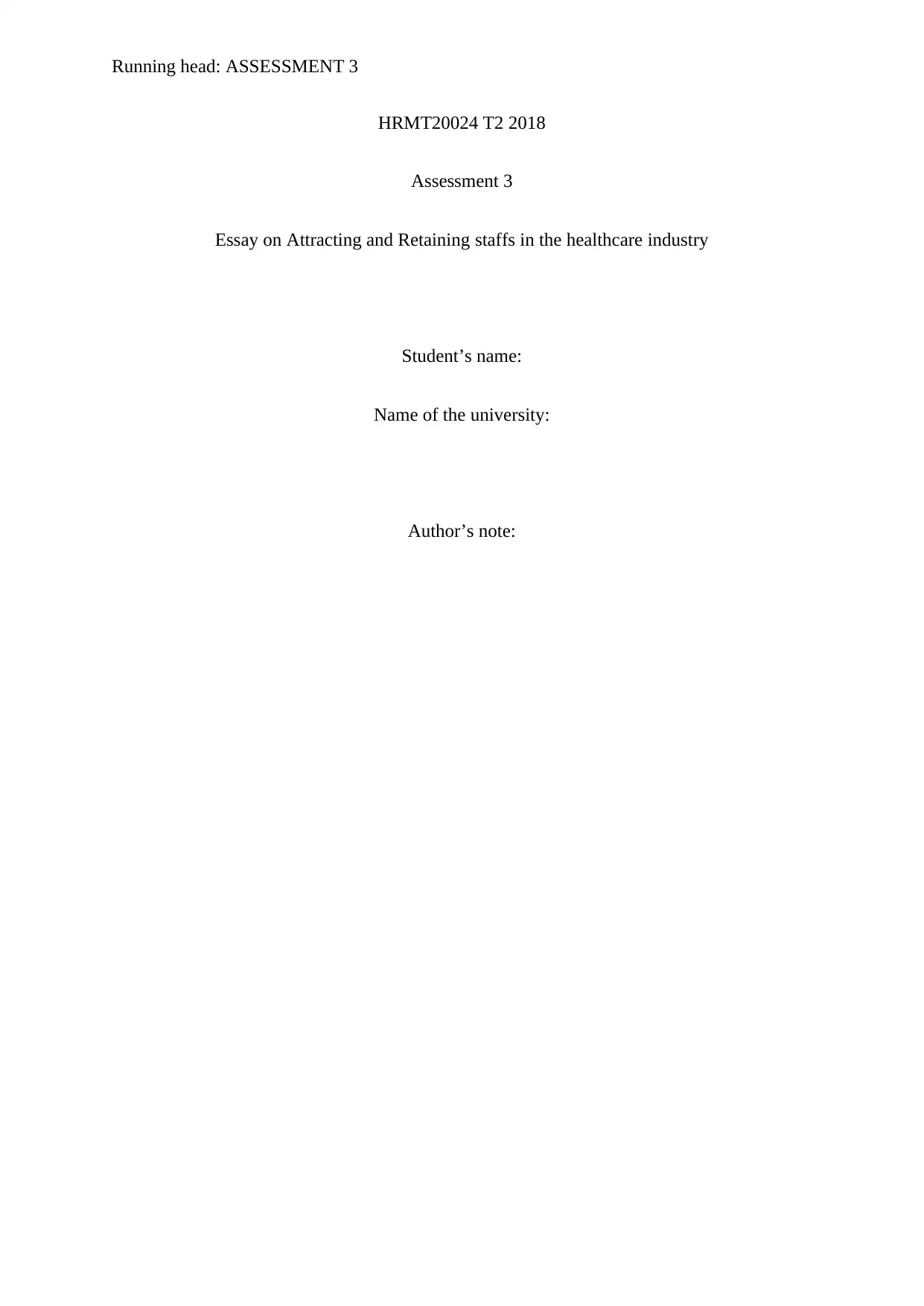
Running head: ASSESSMENT 3
HRMT20024 T2 2018
Assessment 3
Essay on Attracting and Retaining staffs in the healthcare industry
Student’s name:
Name of the university:
Author’s note:
HRMT20024 T2 2018
Assessment 3
Essay on Attracting and Retaining staffs in the healthcare industry
Student’s name:
Name of the university:
Author’s note:
Paraphrase This Document
Need a fresh take? Get an instant paraphrase of this document with our AI Paraphraser

1ASSESSMENT 3
Introduction
Human resources in healthcare feel pressure through increased demand and a shortage
of staffs. The HR department of healthcare overcomes the issues through a better
understanding of the challenges. In Australia, the healthcare sector is growing very fast and
HR professionals are gaining importance in the Healthcare industry (Wilson et al., 2009).
This paper focuses on the challenges of human resources in healthcare sector by investigating
five different themes. In the healthcare sector, the HR department is currently facing the
issues of employee relation challenges, diversity and work-life balance, employee turnover
and retention, performance management and motivation, rewards and compensation. Each of
the challenges is discussed in the following section. It is the primary objective of the HR
department in healthcare to strengthen the healthcare infrastructure, its coverage and
accessibility by developing the conditions of the human resources who are working in the
healthcare sector.
Employee Relations Challenges for HRM
Key stakeholders of industrial relation in healthcare are the employees, employers,
employee association, employer association, government and courts and tribunals. The
concept of employee relation is associated with industrial relations and it includes the process
like employment relationships and the management of conflict between employers, trade
unions and workers. In the healthcare sector, industrial conflict is avoided by developing
harmonious relations among the staffs (Bailey & Peetz, 2014). According to Unitary
approach, the industrial relation is grounded in mutual co-operation, teamwork, shared goals
and individual treatment. Unitary framework assumes that common interest and promotion of
harmony; the employer seeks the direct negotiation with employees (Bilen et al., 2013). On
the other side, Pluralistic approach perceives that it is quite inevitable to understand the
Introduction
Human resources in healthcare feel pressure through increased demand and a shortage
of staffs. The HR department of healthcare overcomes the issues through a better
understanding of the challenges. In Australia, the healthcare sector is growing very fast and
HR professionals are gaining importance in the Healthcare industry (Wilson et al., 2009).
This paper focuses on the challenges of human resources in healthcare sector by investigating
five different themes. In the healthcare sector, the HR department is currently facing the
issues of employee relation challenges, diversity and work-life balance, employee turnover
and retention, performance management and motivation, rewards and compensation. Each of
the challenges is discussed in the following section. It is the primary objective of the HR
department in healthcare to strengthen the healthcare infrastructure, its coverage and
accessibility by developing the conditions of the human resources who are working in the
healthcare sector.
Employee Relations Challenges for HRM
Key stakeholders of industrial relation in healthcare are the employees, employers,
employee association, employer association, government and courts and tribunals. The
concept of employee relation is associated with industrial relations and it includes the process
like employment relationships and the management of conflict between employers, trade
unions and workers. In the healthcare sector, industrial conflict is avoided by developing
harmonious relations among the staffs (Bailey & Peetz, 2014). According to Unitary
approach, the industrial relation is grounded in mutual co-operation, teamwork, shared goals
and individual treatment. Unitary framework assumes that common interest and promotion of
harmony; the employer seeks the direct negotiation with employees (Bilen et al., 2013). On
the other side, Pluralistic approach perceives that it is quite inevitable to understand the
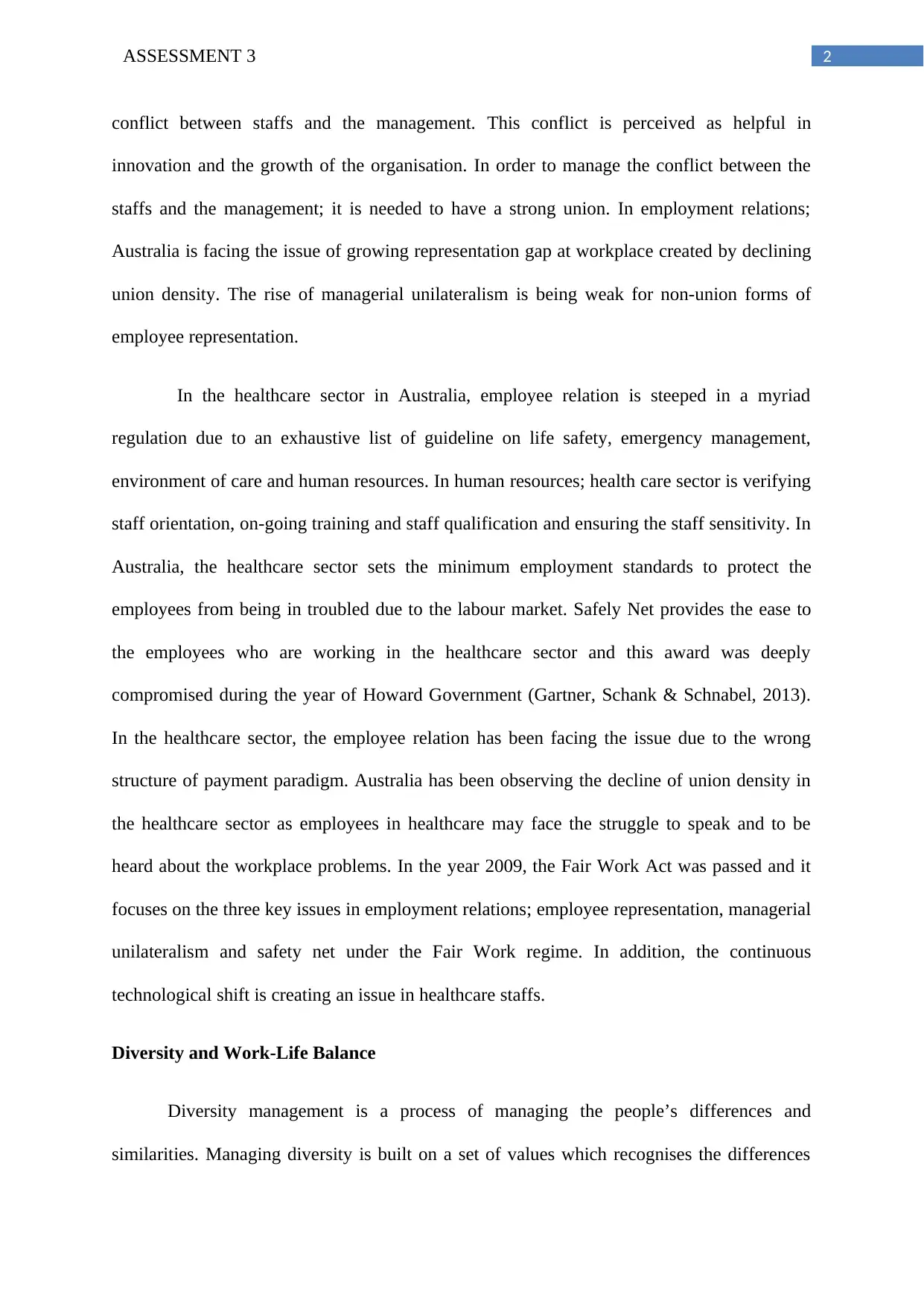
2ASSESSMENT 3
conflict between staffs and the management. This conflict is perceived as helpful in
innovation and the growth of the organisation. In order to manage the conflict between the
staffs and the management; it is needed to have a strong union. In employment relations;
Australia is facing the issue of growing representation gap at workplace created by declining
union density. The rise of managerial unilateralism is being weak for non-union forms of
employee representation.
In the healthcare sector in Australia, employee relation is steeped in a myriad
regulation due to an exhaustive list of guideline on life safety, emergency management,
environment of care and human resources. In human resources; health care sector is verifying
staff orientation, on-going training and staff qualification and ensuring the staff sensitivity. In
Australia, the healthcare sector sets the minimum employment standards to protect the
employees from being in troubled due to the labour market. Safely Net provides the ease to
the employees who are working in the healthcare sector and this award was deeply
compromised during the year of Howard Government (Gartner, Schank & Schnabel, 2013).
In the healthcare sector, the employee relation has been facing the issue due to the wrong
structure of payment paradigm. Australia has been observing the decline of union density in
the healthcare sector as employees in healthcare may face the struggle to speak and to be
heard about the workplace problems. In the year 2009, the Fair Work Act was passed and it
focuses on the three key issues in employment relations; employee representation, managerial
unilateralism and safety net under the Fair Work regime. In addition, the continuous
technological shift is creating an issue in healthcare staffs.
Diversity and Work-Life Balance
Diversity management is a process of managing the people’s differences and
similarities. Managing diversity is built on a set of values which recognises the differences
conflict between staffs and the management. This conflict is perceived as helpful in
innovation and the growth of the organisation. In order to manage the conflict between the
staffs and the management; it is needed to have a strong union. In employment relations;
Australia is facing the issue of growing representation gap at workplace created by declining
union density. The rise of managerial unilateralism is being weak for non-union forms of
employee representation.
In the healthcare sector in Australia, employee relation is steeped in a myriad
regulation due to an exhaustive list of guideline on life safety, emergency management,
environment of care and human resources. In human resources; health care sector is verifying
staff orientation, on-going training and staff qualification and ensuring the staff sensitivity. In
Australia, the healthcare sector sets the minimum employment standards to protect the
employees from being in troubled due to the labour market. Safely Net provides the ease to
the employees who are working in the healthcare sector and this award was deeply
compromised during the year of Howard Government (Gartner, Schank & Schnabel, 2013).
In the healthcare sector, the employee relation has been facing the issue due to the wrong
structure of payment paradigm. Australia has been observing the decline of union density in
the healthcare sector as employees in healthcare may face the struggle to speak and to be
heard about the workplace problems. In the year 2009, the Fair Work Act was passed and it
focuses on the three key issues in employment relations; employee representation, managerial
unilateralism and safety net under the Fair Work regime. In addition, the continuous
technological shift is creating an issue in healthcare staffs.
Diversity and Work-Life Balance
Diversity management is a process of managing the people’s differences and
similarities. Managing diversity is built on a set of values which recognises the differences
⊘ This is a preview!⊘
Do you want full access?
Subscribe today to unlock all pages.

Trusted by 1+ million students worldwide
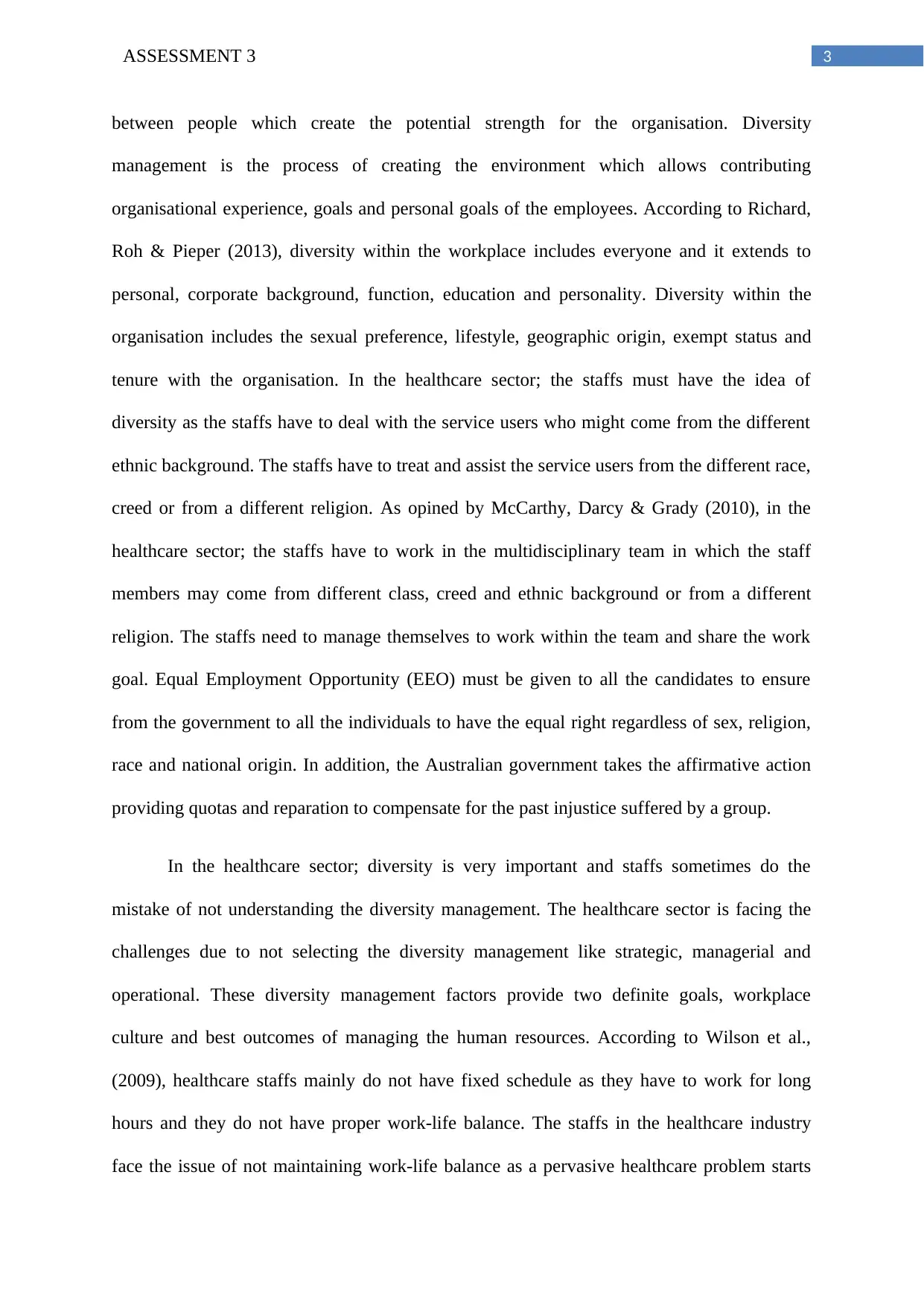
3ASSESSMENT 3
between people which create the potential strength for the organisation. Diversity
management is the process of creating the environment which allows contributing
organisational experience, goals and personal goals of the employees. According to Richard,
Roh & Pieper (2013), diversity within the workplace includes everyone and it extends to
personal, corporate background, function, education and personality. Diversity within the
organisation includes the sexual preference, lifestyle, geographic origin, exempt status and
tenure with the organisation. In the healthcare sector; the staffs must have the idea of
diversity as the staffs have to deal with the service users who might come from the different
ethnic background. The staffs have to treat and assist the service users from the different race,
creed or from a different religion. As opined by McCarthy, Darcy & Grady (2010), in the
healthcare sector; the staffs have to work in the multidisciplinary team in which the staff
members may come from different class, creed and ethnic background or from a different
religion. The staffs need to manage themselves to work within the team and share the work
goal. Equal Employment Opportunity (EEO) must be given to all the candidates to ensure
from the government to all the individuals to have the equal right regardless of sex, religion,
race and national origin. In addition, the Australian government takes the affirmative action
providing quotas and reparation to compensate for the past injustice suffered by a group.
In the healthcare sector; diversity is very important and staffs sometimes do the
mistake of not understanding the diversity management. The healthcare sector is facing the
challenges due to not selecting the diversity management like strategic, managerial and
operational. These diversity management factors provide two definite goals, workplace
culture and best outcomes of managing the human resources. According to Wilson et al.,
(2009), healthcare staffs mainly do not have fixed schedule as they have to work for long
hours and they do not have proper work-life balance. The staffs in the healthcare industry
face the issue of not maintaining work-life balance as a pervasive healthcare problem starts
between people which create the potential strength for the organisation. Diversity
management is the process of creating the environment which allows contributing
organisational experience, goals and personal goals of the employees. According to Richard,
Roh & Pieper (2013), diversity within the workplace includes everyone and it extends to
personal, corporate background, function, education and personality. Diversity within the
organisation includes the sexual preference, lifestyle, geographic origin, exempt status and
tenure with the organisation. In the healthcare sector; the staffs must have the idea of
diversity as the staffs have to deal with the service users who might come from the different
ethnic background. The staffs have to treat and assist the service users from the different race,
creed or from a different religion. As opined by McCarthy, Darcy & Grady (2010), in the
healthcare sector; the staffs have to work in the multidisciplinary team in which the staff
members may come from different class, creed and ethnic background or from a different
religion. The staffs need to manage themselves to work within the team and share the work
goal. Equal Employment Opportunity (EEO) must be given to all the candidates to ensure
from the government to all the individuals to have the equal right regardless of sex, religion,
race and national origin. In addition, the Australian government takes the affirmative action
providing quotas and reparation to compensate for the past injustice suffered by a group.
In the healthcare sector; diversity is very important and staffs sometimes do the
mistake of not understanding the diversity management. The healthcare sector is facing the
challenges due to not selecting the diversity management like strategic, managerial and
operational. These diversity management factors provide two definite goals, workplace
culture and best outcomes of managing the human resources. According to Wilson et al.,
(2009), healthcare staffs mainly do not have fixed schedule as they have to work for long
hours and they do not have proper work-life balance. The staffs in the healthcare industry
face the issue of not maintaining work-life balance as a pervasive healthcare problem starts
Paraphrase This Document
Need a fresh take? Get an instant paraphrase of this document with our AI Paraphraser

4ASSESSMENT 3
with loss of mental, emotional and physical energy due to job stress. Work-life balance is
making the perfect harmony between the family and work; however, healthcare industry
affects the commitment of perfect work-life balance.
Employee turnover and retention
There are two types of turnover within the workplace, the first one is voluntary
turnover and the second one is involuntary turnover. Employee turnover in an organisation is
the employee leaving rate and the organisations most of the time try to retain the employees.
In order to manage the involuntary turnover; the organisations focus on distributive fairness,
procedural fairness and interpersonal fairness. Distributive fairness is the judgment that the
employees make with respect to the result received in relation to contribution and the
procedural fairness is the concept of justice which focuses on the methods utilised to
determine the result they received (Hom et al., 2017). In New Zealand and in Australia, the
healthcare industry turnover of the employees is 30% worse than other industries. The rate of
employee retention is higher due to poor employee selection strategies and recruitment
procedure. Employee turnover challenge is major in healthcare sector due to the involuntary
termination as the employees do not have the proper personality traits, interpersonal
behaviour, professionalism, lack of emotional intelligence and poor decision-making
capacity. The employee turnover in the healthcare sector is high due to workload as the
demands of healthcare professionals is getting higher nowadays and the healthcare firms are
trying to roll out the new quality along with cost-control initiative. The organisations are
trying to evaluate the candidates' ability to handle the stress and adapt the ability to making
the employees more important (Kramar et al., 2013). Moreover, in the healthcare industry;
the staffs do not like the immediate supervisor and it assesses each candidate's leadership
potential so that the healthcare professionals do not become poor leaders. In addition, the
healthcare professionals sometimes may have the poor relationship with the colleagues and
with loss of mental, emotional and physical energy due to job stress. Work-life balance is
making the perfect harmony between the family and work; however, healthcare industry
affects the commitment of perfect work-life balance.
Employee turnover and retention
There are two types of turnover within the workplace, the first one is voluntary
turnover and the second one is involuntary turnover. Employee turnover in an organisation is
the employee leaving rate and the organisations most of the time try to retain the employees.
In order to manage the involuntary turnover; the organisations focus on distributive fairness,
procedural fairness and interpersonal fairness. Distributive fairness is the judgment that the
employees make with respect to the result received in relation to contribution and the
procedural fairness is the concept of justice which focuses on the methods utilised to
determine the result they received (Hom et al., 2017). In New Zealand and in Australia, the
healthcare industry turnover of the employees is 30% worse than other industries. The rate of
employee retention is higher due to poor employee selection strategies and recruitment
procedure. Employee turnover challenge is major in healthcare sector due to the involuntary
termination as the employees do not have the proper personality traits, interpersonal
behaviour, professionalism, lack of emotional intelligence and poor decision-making
capacity. The employee turnover in the healthcare sector is high due to workload as the
demands of healthcare professionals is getting higher nowadays and the healthcare firms are
trying to roll out the new quality along with cost-control initiative. The organisations are
trying to evaluate the candidates' ability to handle the stress and adapt the ability to making
the employees more important (Kramar et al., 2013). Moreover, in the healthcare industry;
the staffs do not like the immediate supervisor and it assesses each candidate's leadership
potential so that the healthcare professionals do not become poor leaders. In addition, the
healthcare professionals sometimes may have the poor relationship with the colleagues and
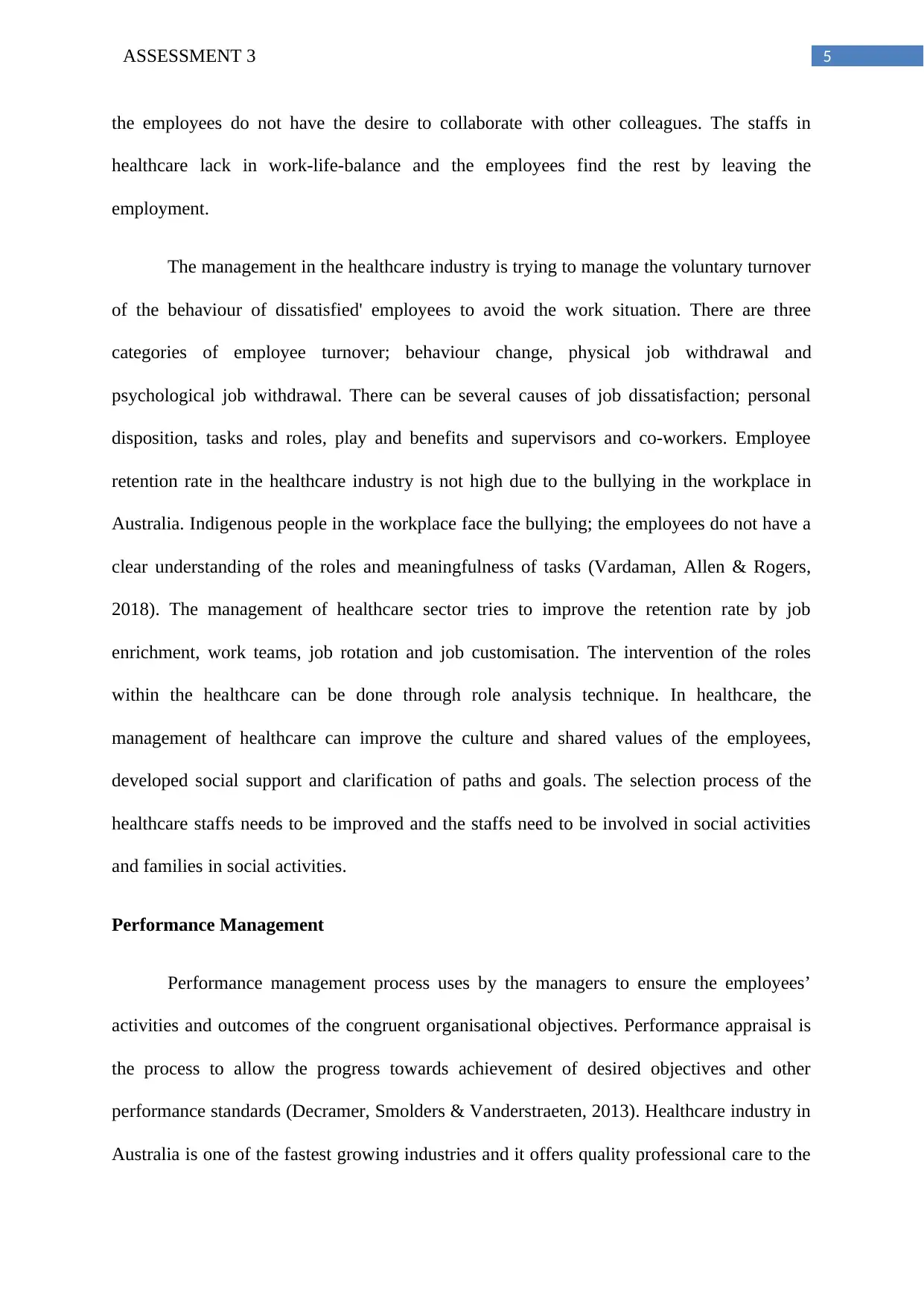
5ASSESSMENT 3
the employees do not have the desire to collaborate with other colleagues. The staffs in
healthcare lack in work-life-balance and the employees find the rest by leaving the
employment.
The management in the healthcare industry is trying to manage the voluntary turnover
of the behaviour of dissatisfied' employees to avoid the work situation. There are three
categories of employee turnover; behaviour change, physical job withdrawal and
psychological job withdrawal. There can be several causes of job dissatisfaction; personal
disposition, tasks and roles, play and benefits and supervisors and co-workers. Employee
retention rate in the healthcare industry is not high due to the bullying in the workplace in
Australia. Indigenous people in the workplace face the bullying; the employees do not have a
clear understanding of the roles and meaningfulness of tasks (Vardaman, Allen & Rogers,
2018). The management of healthcare sector tries to improve the retention rate by job
enrichment, work teams, job rotation and job customisation. The intervention of the roles
within the healthcare can be done through role analysis technique. In healthcare, the
management of healthcare can improve the culture and shared values of the employees,
developed social support and clarification of paths and goals. The selection process of the
healthcare staffs needs to be improved and the staffs need to be involved in social activities
and families in social activities.
Performance Management
Performance management process uses by the managers to ensure the employees’
activities and outcomes of the congruent organisational objectives. Performance appraisal is
the process to allow the progress towards achievement of desired objectives and other
performance standards (Decramer, Smolders & Vanderstraeten, 2013). Healthcare industry in
Australia is one of the fastest growing industries and it offers quality professional care to the
the employees do not have the desire to collaborate with other colleagues. The staffs in
healthcare lack in work-life-balance and the employees find the rest by leaving the
employment.
The management in the healthcare industry is trying to manage the voluntary turnover
of the behaviour of dissatisfied' employees to avoid the work situation. There are three
categories of employee turnover; behaviour change, physical job withdrawal and
psychological job withdrawal. There can be several causes of job dissatisfaction; personal
disposition, tasks and roles, play and benefits and supervisors and co-workers. Employee
retention rate in the healthcare industry is not high due to the bullying in the workplace in
Australia. Indigenous people in the workplace face the bullying; the employees do not have a
clear understanding of the roles and meaningfulness of tasks (Vardaman, Allen & Rogers,
2018). The management of healthcare sector tries to improve the retention rate by job
enrichment, work teams, job rotation and job customisation. The intervention of the roles
within the healthcare can be done through role analysis technique. In healthcare, the
management of healthcare can improve the culture and shared values of the employees,
developed social support and clarification of paths and goals. The selection process of the
healthcare staffs needs to be improved and the staffs need to be involved in social activities
and families in social activities.
Performance Management
Performance management process uses by the managers to ensure the employees’
activities and outcomes of the congruent organisational objectives. Performance appraisal is
the process to allow the progress towards achievement of desired objectives and other
performance standards (Decramer, Smolders & Vanderstraeten, 2013). Healthcare industry in
Australia is one of the fastest growing industries and it offers quality professional care to the
⊘ This is a preview!⊘
Do you want full access?
Subscribe today to unlock all pages.

Trusted by 1+ million students worldwide
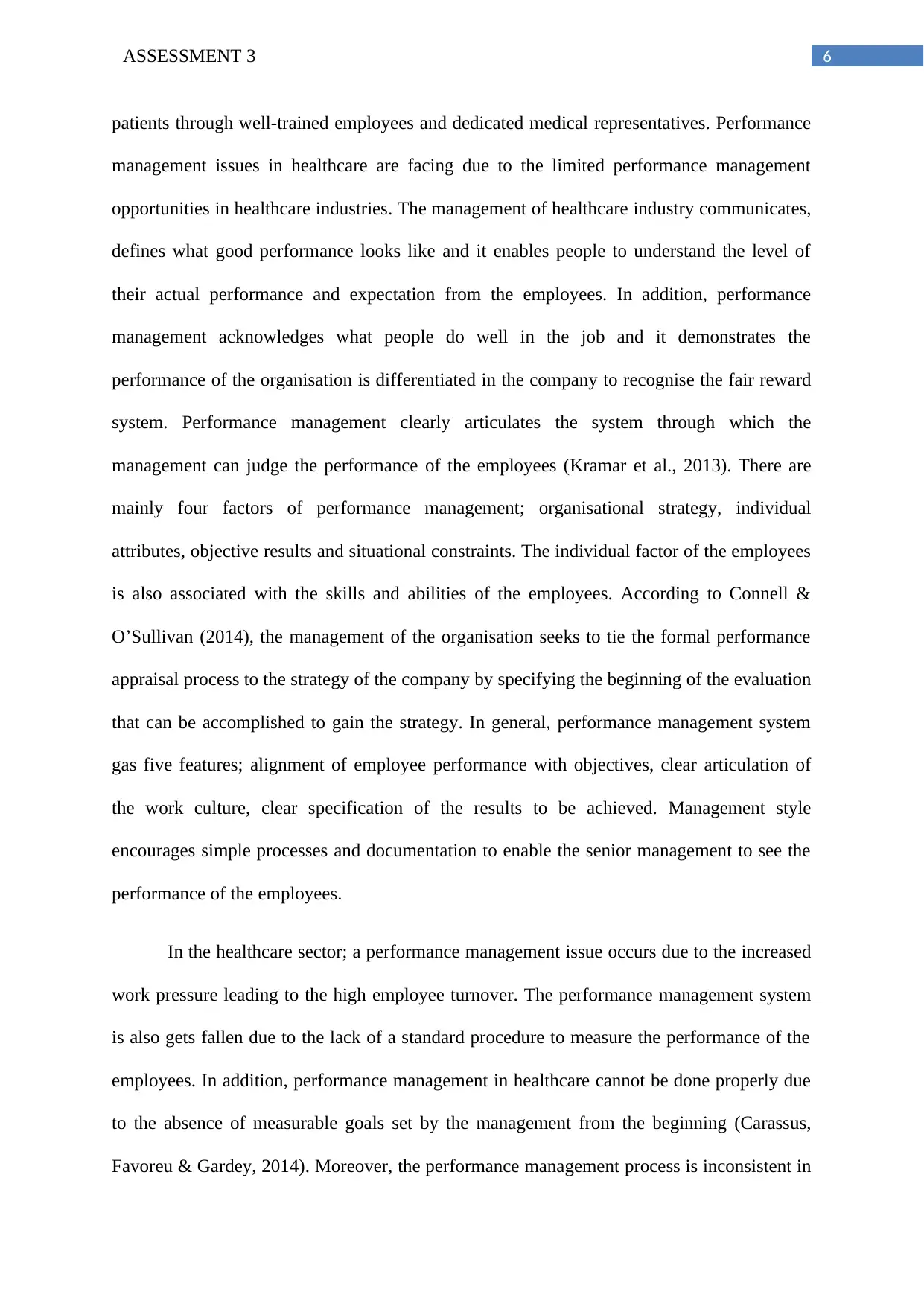
6ASSESSMENT 3
patients through well-trained employees and dedicated medical representatives. Performance
management issues in healthcare are facing due to the limited performance management
opportunities in healthcare industries. The management of healthcare industry communicates,
defines what good performance looks like and it enables people to understand the level of
their actual performance and expectation from the employees. In addition, performance
management acknowledges what people do well in the job and it demonstrates the
performance of the organisation is differentiated in the company to recognise the fair reward
system. Performance management clearly articulates the system through which the
management can judge the performance of the employees (Kramar et al., 2013). There are
mainly four factors of performance management; organisational strategy, individual
attributes, objective results and situational constraints. The individual factor of the employees
is also associated with the skills and abilities of the employees. According to Connell &
O’Sullivan (2014), the management of the organisation seeks to tie the formal performance
appraisal process to the strategy of the company by specifying the beginning of the evaluation
that can be accomplished to gain the strategy. In general, performance management system
gas five features; alignment of employee performance with objectives, clear articulation of
the work culture, clear specification of the results to be achieved. Management style
encourages simple processes and documentation to enable the senior management to see the
performance of the employees.
In the healthcare sector; a performance management issue occurs due to the increased
work pressure leading to the high employee turnover. The performance management system
is also gets fallen due to the lack of a standard procedure to measure the performance of the
employees. In addition, performance management in healthcare cannot be done properly due
to the absence of measurable goals set by the management from the beginning (Carassus,
Favoreu & Gardey, 2014). Moreover, the performance management process is inconsistent in
patients through well-trained employees and dedicated medical representatives. Performance
management issues in healthcare are facing due to the limited performance management
opportunities in healthcare industries. The management of healthcare industry communicates,
defines what good performance looks like and it enables people to understand the level of
their actual performance and expectation from the employees. In addition, performance
management acknowledges what people do well in the job and it demonstrates the
performance of the organisation is differentiated in the company to recognise the fair reward
system. Performance management clearly articulates the system through which the
management can judge the performance of the employees (Kramar et al., 2013). There are
mainly four factors of performance management; organisational strategy, individual
attributes, objective results and situational constraints. The individual factor of the employees
is also associated with the skills and abilities of the employees. According to Connell &
O’Sullivan (2014), the management of the organisation seeks to tie the formal performance
appraisal process to the strategy of the company by specifying the beginning of the evaluation
that can be accomplished to gain the strategy. In general, performance management system
gas five features; alignment of employee performance with objectives, clear articulation of
the work culture, clear specification of the results to be achieved. Management style
encourages simple processes and documentation to enable the senior management to see the
performance of the employees.
In the healthcare sector; a performance management issue occurs due to the increased
work pressure leading to the high employee turnover. The performance management system
is also gets fallen due to the lack of a standard procedure to measure the performance of the
employees. In addition, performance management in healthcare cannot be done properly due
to the absence of measurable goals set by the management from the beginning (Carassus,
Favoreu & Gardey, 2014). Moreover, the performance management process is inconsistent in
Paraphrase This Document
Need a fresh take? Get an instant paraphrase of this document with our AI Paraphraser

7ASSESSMENT 3
performance reviews of the management. There is no such systematic way to review the
performance of the employees and the management does not have a tracker to take the well-
informed decision. In the healthcare industry in Australia, the HR department needs to set the
performance measurement criteria to set the strategic congruence to elicit the job
performance which is consistent with the organisational goal, strategy and culture. Ettner et
al., (2016) commented that the HR department can take the comparative approach, attributive
approach and behavioural approach to measure the performance of the employees.
Motivation, Rewards and Compensation
The healthcare employees have been facing the issue in Australia due to not having a
clear pay structure in the industry. Pay structure is the relative pay of different jobs and how
much they paid in pay level. In the healthcare sector in Australia, the firms do not follow the
pay level as the average pay, salaries, bonus, including wages and fringe benefits (Chinag &
Birtch, 2010). As stated by Kim, Sutton & Gong (2013), equity theory evaluates the fairness
of the situation by understanding and comparing the people. Equity theory tries to compare
the person's ratio of perceived outcome (benefits, pay, working condition) to perceived inputs
(likeability, effort and experience) to the ratio of comparison others. In the healthcare sector,
pay structure is not formulated correctly due to the labour-market competition. The HR
department of the healthcare firm does not create the pay-policy line and the pay grade
properly. Pay grade is the jobs of similar worth for pay administration purposes. HR
department focuses on market pay-structure which can differ substantially across the
countries in terms of the relative worth of jobs. Employee participation and communication
play important role in the motivation of the employees. Compensation challenges and
rewards of the employees in healthcare have been there for the job-based pay structure which
may encourage the employer in bureaucracy (Van Jaarsveld & Yanadori, 2011). The
organisations focus on structure's hierarchy to reinforce the top-down decision-making and
performance reviews of the management. There is no such systematic way to review the
performance of the employees and the management does not have a tracker to take the well-
informed decision. In the healthcare industry in Australia, the HR department needs to set the
performance measurement criteria to set the strategic congruence to elicit the job
performance which is consistent with the organisational goal, strategy and culture. Ettner et
al., (2016) commented that the HR department can take the comparative approach, attributive
approach and behavioural approach to measure the performance of the employees.
Motivation, Rewards and Compensation
The healthcare employees have been facing the issue in Australia due to not having a
clear pay structure in the industry. Pay structure is the relative pay of different jobs and how
much they paid in pay level. In the healthcare sector in Australia, the firms do not follow the
pay level as the average pay, salaries, bonus, including wages and fringe benefits (Chinag &
Birtch, 2010). As stated by Kim, Sutton & Gong (2013), equity theory evaluates the fairness
of the situation by understanding and comparing the people. Equity theory tries to compare
the person's ratio of perceived outcome (benefits, pay, working condition) to perceived inputs
(likeability, effort and experience) to the ratio of comparison others. In the healthcare sector,
pay structure is not formulated correctly due to the labour-market competition. The HR
department of the healthcare firm does not create the pay-policy line and the pay grade
properly. Pay grade is the jobs of similar worth for pay administration purposes. HR
department focuses on market pay-structure which can differ substantially across the
countries in terms of the relative worth of jobs. Employee participation and communication
play important role in the motivation of the employees. Compensation challenges and
rewards of the employees in healthcare have been there for the job-based pay structure which
may encourage the employer in bureaucracy (Van Jaarsveld & Yanadori, 2011). The
organisations focus on structure's hierarchy to reinforce the top-down decision-making and
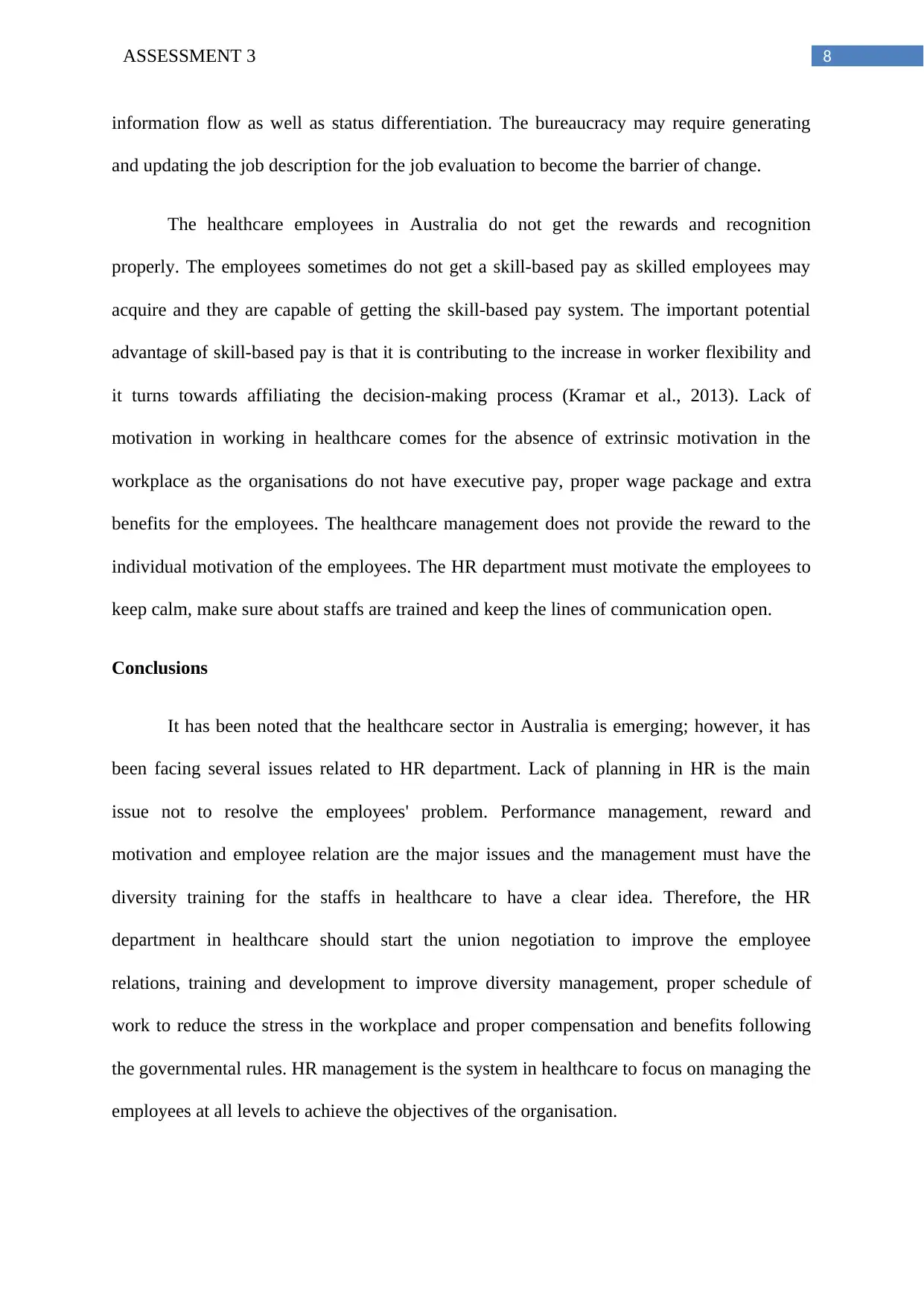
8ASSESSMENT 3
information flow as well as status differentiation. The bureaucracy may require generating
and updating the job description for the job evaluation to become the barrier of change.
The healthcare employees in Australia do not get the rewards and recognition
properly. The employees sometimes do not get a skill-based pay as skilled employees may
acquire and they are capable of getting the skill-based pay system. The important potential
advantage of skill-based pay is that it is contributing to the increase in worker flexibility and
it turns towards affiliating the decision-making process (Kramar et al., 2013). Lack of
motivation in working in healthcare comes for the absence of extrinsic motivation in the
workplace as the organisations do not have executive pay, proper wage package and extra
benefits for the employees. The healthcare management does not provide the reward to the
individual motivation of the employees. The HR department must motivate the employees to
keep calm, make sure about staffs are trained and keep the lines of communication open.
Conclusions
It has been noted that the healthcare sector in Australia is emerging; however, it has
been facing several issues related to HR department. Lack of planning in HR is the main
issue not to resolve the employees' problem. Performance management, reward and
motivation and employee relation are the major issues and the management must have the
diversity training for the staffs in healthcare to have a clear idea. Therefore, the HR
department in healthcare should start the union negotiation to improve the employee
relations, training and development to improve diversity management, proper schedule of
work to reduce the stress in the workplace and proper compensation and benefits following
the governmental rules. HR management is the system in healthcare to focus on managing the
employees at all levels to achieve the objectives of the organisation.
information flow as well as status differentiation. The bureaucracy may require generating
and updating the job description for the job evaluation to become the barrier of change.
The healthcare employees in Australia do not get the rewards and recognition
properly. The employees sometimes do not get a skill-based pay as skilled employees may
acquire and they are capable of getting the skill-based pay system. The important potential
advantage of skill-based pay is that it is contributing to the increase in worker flexibility and
it turns towards affiliating the decision-making process (Kramar et al., 2013). Lack of
motivation in working in healthcare comes for the absence of extrinsic motivation in the
workplace as the organisations do not have executive pay, proper wage package and extra
benefits for the employees. The healthcare management does not provide the reward to the
individual motivation of the employees. The HR department must motivate the employees to
keep calm, make sure about staffs are trained and keep the lines of communication open.
Conclusions
It has been noted that the healthcare sector in Australia is emerging; however, it has
been facing several issues related to HR department. Lack of planning in HR is the main
issue not to resolve the employees' problem. Performance management, reward and
motivation and employee relation are the major issues and the management must have the
diversity training for the staffs in healthcare to have a clear idea. Therefore, the HR
department in healthcare should start the union negotiation to improve the employee
relations, training and development to improve diversity management, proper schedule of
work to reduce the stress in the workplace and proper compensation and benefits following
the governmental rules. HR management is the system in healthcare to focus on managing the
employees at all levels to achieve the objectives of the organisation.
⊘ This is a preview!⊘
Do you want full access?
Subscribe today to unlock all pages.

Trusted by 1+ million students worldwide

9ASSESSMENT 3
Reference List
Bailey, J & Peetz, D 2014, 'Australian unions and collective bargaining in 2013', Journal of
Industrial Relations, vol. 56, no. 3, 415-432.
Blien, U, Dauth, W, Schank, T & Schnabel, C 2013, 'The Institutional context of an
'Empirical Law': The wage curve under different regimes of collective bargaining',
British Journal of Industrial Relations, vol. 51, no. 1, 59-79.
Carassus, D, Favoreu, C & Gardey, D 2014, 'Factors that Determine or Influence Managerial
Innovation in Public Contexts: The Case of Local Performance Management', Public
Organization Review, vol. 14, no. 2, 245-266.
Chiang, FF & Birtch, TA 2010, 'Pay for performance and work attitudes: The mediating role
of employee-organization service value congruence', International Journal of
Hospitality Management, vol. 29, no. 4, 632-640.
Connell, V & O'Sullivan, D 2014, 'The influence of lead indicator strength on the use of
nonfinancial measures in performance management: Evidence from CEO
compensation schemes', Strategic Management Journal, vol. 35, no. 6, 826-844.
Decramer, A, Smolders, C & Vanderstraeten, A 2013, 'Employee performance management
culture and system features in higher education: relationship with employee
performance management satisfaction', The International Journal of Human Resource
Management, vol. 24, no. 2, 352-371.
Ettner, R., Ettner, F., & White, T. 2016. ‘Choosing a Surgeon: An Exploratory Study of
Factors Influencing Selection of a Gender Affirmation Surgeon’. Transgender Health,
vol. 1, no. 1, 124–128.
Reference List
Bailey, J & Peetz, D 2014, 'Australian unions and collective bargaining in 2013', Journal of
Industrial Relations, vol. 56, no. 3, 415-432.
Blien, U, Dauth, W, Schank, T & Schnabel, C 2013, 'The Institutional context of an
'Empirical Law': The wage curve under different regimes of collective bargaining',
British Journal of Industrial Relations, vol. 51, no. 1, 59-79.
Carassus, D, Favoreu, C & Gardey, D 2014, 'Factors that Determine or Influence Managerial
Innovation in Public Contexts: The Case of Local Performance Management', Public
Organization Review, vol. 14, no. 2, 245-266.
Chiang, FF & Birtch, TA 2010, 'Pay for performance and work attitudes: The mediating role
of employee-organization service value congruence', International Journal of
Hospitality Management, vol. 29, no. 4, 632-640.
Connell, V & O'Sullivan, D 2014, 'The influence of lead indicator strength on the use of
nonfinancial measures in performance management: Evidence from CEO
compensation schemes', Strategic Management Journal, vol. 35, no. 6, 826-844.
Decramer, A, Smolders, C & Vanderstraeten, A 2013, 'Employee performance management
culture and system features in higher education: relationship with employee
performance management satisfaction', The International Journal of Human Resource
Management, vol. 24, no. 2, 352-371.
Ettner, R., Ettner, F., & White, T. 2016. ‘Choosing a Surgeon: An Exploratory Study of
Factors Influencing Selection of a Gender Affirmation Surgeon’. Transgender Health,
vol. 1, no. 1, 124–128.
Paraphrase This Document
Need a fresh take? Get an instant paraphrase of this document with our AI Paraphraser

10ASSESSMENT 3
Gartner, H, Schank, T & Schnabel, C 2013, 'Wage cyclicality under different regimes of
industrial relations', Industrial Relations: A Journal of Economy and Society, vol. 52,
no. 2, 516-540.
Hom, P.W., Lee, T.W., Shaw, J.D. & Hausknecht, J.P., 2017. ‘One hundred years of
employee turnover theory and research’. Journal of Applied Psychology, vol. 102, no.
3, 530.
Kim, H, Sutton, KL & Gong, Y 2013, 'Group-based pay-for-performance plans and firm
performance: The moderating role of empowerment practices', Asia Pacific Journal of
Management, vol. 30, no. 1, 31-52.
Kramar, Bartram, De Cieri, Noe, Hollenbeck, Gerhart, . . . Wright, Patrick M. (2013). Human
resource management in Australia: Strategy, people, performance (Fifth ed.). North
Ryde, N.S.W.: McGraw-Hill Education.
McCarthy, A, Darcy, C & Grady, G 2010, 'Work-life balance policy and practice:
Understanding line manager attitudes and behaviours', Human Resource Management
Review, vol. 20, no. 2, 158-167.
Richard, OC, Roh, H & Pieper, JR 2013, 'The link between diversity and equality
management practice bundles and racial diversity in the managerial ranks: does firm
size matter?' Human Resource Management, vol 52, no. 2, 215-242.
Van Jaarsveld, DD & Yanadori, Y 2011, 'Compensation management in outsourced service
organizations and its implications for quit rates, absenteeism and workforce
performance: Evidence from Canadian call centres', British Journal of Industrial
Relations, vol. 49, no. s1, s1-s26.
Gartner, H, Schank, T & Schnabel, C 2013, 'Wage cyclicality under different regimes of
industrial relations', Industrial Relations: A Journal of Economy and Society, vol. 52,
no. 2, 516-540.
Hom, P.W., Lee, T.W., Shaw, J.D. & Hausknecht, J.P., 2017. ‘One hundred years of
employee turnover theory and research’. Journal of Applied Psychology, vol. 102, no.
3, 530.
Kim, H, Sutton, KL & Gong, Y 2013, 'Group-based pay-for-performance plans and firm
performance: The moderating role of empowerment practices', Asia Pacific Journal of
Management, vol. 30, no. 1, 31-52.
Kramar, Bartram, De Cieri, Noe, Hollenbeck, Gerhart, . . . Wright, Patrick M. (2013). Human
resource management in Australia: Strategy, people, performance (Fifth ed.). North
Ryde, N.S.W.: McGraw-Hill Education.
McCarthy, A, Darcy, C & Grady, G 2010, 'Work-life balance policy and practice:
Understanding line manager attitudes and behaviours', Human Resource Management
Review, vol. 20, no. 2, 158-167.
Richard, OC, Roh, H & Pieper, JR 2013, 'The link between diversity and equality
management practice bundles and racial diversity in the managerial ranks: does firm
size matter?' Human Resource Management, vol 52, no. 2, 215-242.
Van Jaarsveld, DD & Yanadori, Y 2011, 'Compensation management in outsourced service
organizations and its implications for quit rates, absenteeism and workforce
performance: Evidence from Canadian call centres', British Journal of Industrial
Relations, vol. 49, no. s1, s1-s26.
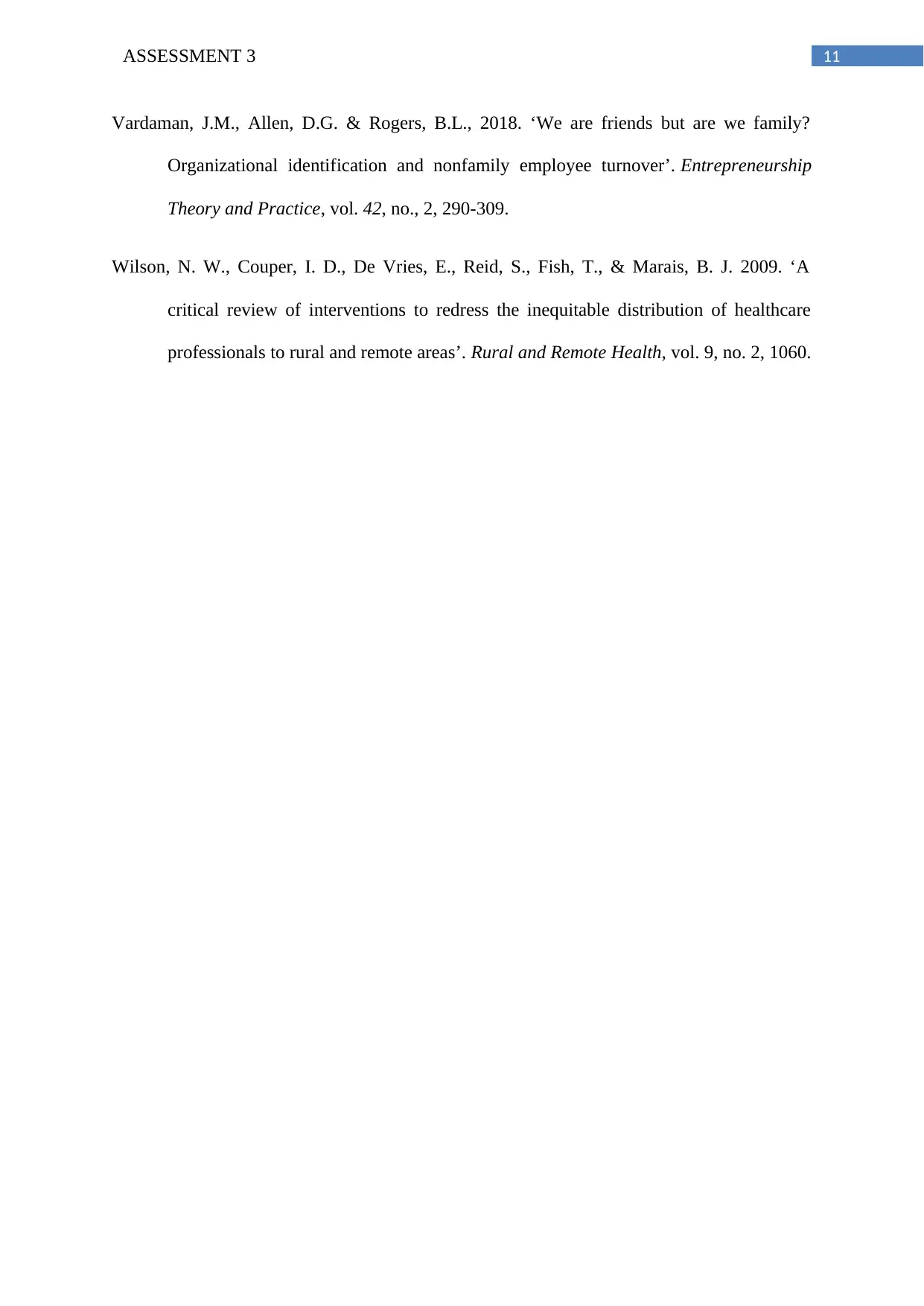
11ASSESSMENT 3
Vardaman, J.M., Allen, D.G. & Rogers, B.L., 2018. ‘We are friends but are we family?
Organizational identification and nonfamily employee turnover’. Entrepreneurship
Theory and Practice, vol. 42, no., 2, 290-309.
Wilson, N. W., Couper, I. D., De Vries, E., Reid, S., Fish, T., & Marais, B. J. 2009. ‘A
critical review of interventions to redress the inequitable distribution of healthcare
professionals to rural and remote areas’. Rural and Remote Health, vol. 9, no. 2, 1060.
Vardaman, J.M., Allen, D.G. & Rogers, B.L., 2018. ‘We are friends but are we family?
Organizational identification and nonfamily employee turnover’. Entrepreneurship
Theory and Practice, vol. 42, no., 2, 290-309.
Wilson, N. W., Couper, I. D., De Vries, E., Reid, S., Fish, T., & Marais, B. J. 2009. ‘A
critical review of interventions to redress the inequitable distribution of healthcare
professionals to rural and remote areas’. Rural and Remote Health, vol. 9, no. 2, 1060.
⊘ This is a preview!⊘
Do you want full access?
Subscribe today to unlock all pages.

Trusted by 1+ million students worldwide
1 out of 12
Related Documents
Your All-in-One AI-Powered Toolkit for Academic Success.
+13062052269
info@desklib.com
Available 24*7 on WhatsApp / Email
![[object Object]](/_next/static/media/star-bottom.7253800d.svg)
Unlock your academic potential
Copyright © 2020–2025 A2Z Services. All Rights Reserved. Developed and managed by ZUCOL.





